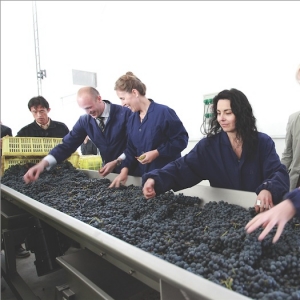An international winemaking competition in China has been won by a Marlborough man, with a second Marlborough winemaker also taking one of the top three places.
The Ningxia Wine Challenge began back in 2012 – and was seen as a way of promoting China’s fastest growing wine region. Winemakers from around the world were invited to apply to take part in the competition, which would see them responsible for making one red wine in 2012, followed by a white wine in 2013.
Both wines would then be judged by a panel in 2014, with three top placings in each category announced.
Of the seven winemakers, two came from New Zealand, David Tyney and Patricia Miranda-Taylor, both based in Marlborough.
Tyney says the competition, due to its novelty, initially garnered strong media publicity around the world, which was exactly what the regional government had wanted. But the drawn out aspect which has seen him make seven trips to Ningxia, meant many of the initial competitors pulled out before the white wine was produced in 2013.
“At the beginning there was a lot of hype, a lot of media attention and everyone was involved. But after two years, it began to lose impetus. Three of us were committed to it, a French winemaker, a Spanish one and myself.”
The red wine made in 2012, was a Cabernet Sauvignon, blended with Cabernet Gernischt. All the fruit came from one vineyard and the seven winemakers had to make the decision when and how to pick the fruit. They were then responsible for taking that fruit back to the brand new winery, built specifically for the competitors, and turning it into wine.
In Tyney’s case, he admits he was pretty sceptical about the quality that came in. So he decided to take a very low risk approach to the winemaking side.
“Basically I pressed directly to barrel and I didn’t touch those barrels for 18 months. While I was sceptical about the fruit, as the wines aged, and they definitely need to age, they really developed some nice richness and complexity.”
He says it was the same with the white wine, which was a Chardonnay made in 2013.
“I also full bunch pressed straight to barrel and because it had seeds and grapes floating in it, everyone in the winery and the experts who came in to taste would call me up saying there was something wrong, as there were seeds and grapes floating in the barrels. I just told them to leave them, not to touch anything. That was something completely different to them. But I guess the proof is in the pudding, as they say.”
In September the contestants were invited back for the judging, of seven red wines and three white. Held in Beijing, a panel of six judges, including other international winemakers, sommeliers and wine professors, tasted the finished wines. The winners were announced straight away with Tyney taking out first place with both the red and the white. Miranda-Taylor was placed third in the red wine section – a major feather in the cap for the Marlborough winemakers.
However it is unlikely that many will ever get to try for themselves the end product of the competition Tyney says. All the wines have been labelled with photos of the relevant winemaker and are being held in a specially built wine museum in the Ningxia region.
As for the future, the competition has certainly highlighted Ningxia, Tyney says.
“When I first went there, just under three years ago, the aim was to have 60,000 hectares of planted vines within five years. That’s still the goal.
“At the moment there are 58 wineries and they want another 100 approved winemaking facilities. A good percentage of those are going to be from outside investment and international wine companies wanting to invest in China. In the past few years there have been some pretty big names become involved, companies from Napa, South America and Europe. Already LVMH and Pernod Ricard are present in Ningxia. And there are 30,000 hectares already planted. But the total annual crush is only 15,000 tonne – which is due to the young vines not being on stream and the older plantings not having had a very good strike rate. So they still have a long way to go.”
Ningxia is one of China’s six major wine producing regions and has already gained a reputation for consistently high quality red wines. However Tyney says the viticultural knowledge along with sales and marketing of a brand are still lacking in expertise.
Tyney will continue to be a frequent visitor to China, where he has become a winemaking consultant and is also marketing his own Marlborough wine Cirro.












